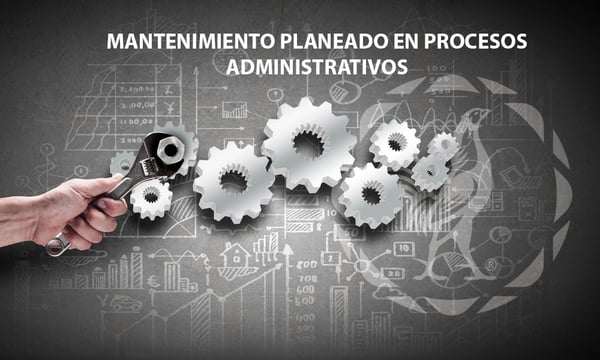
Because of the implementation of the TPM methodology within the operations department at Casa Sauza, we have managed to increase our productivity at a lower cost. Our employees better utilize the equipment and have improved their skills to such a degree that they are now “Technical Operators.” Find out how we have achieved this at Casa Sauza.
Because of our operational success using the TPM methodology, Casa Sauza has chosen to apply the TPM pillars in the administrative areas of the company. In this blog post, we will discuss the Planned Maintenance pillar, and its impact on the administrative processes and analyze 3 of the 7 steps of this methodology.
Let’s begin by defining planned maintenance.
What is Planned Maintenance
The Planned Maintenance pillar has two objectives to achieve:
- Improve the effectiveness of operational equipment
- Reduce maintenance costs and equipment failure through scheduled maintenance
The two metrics I monitor are equipment breakdowns and costs. Success is achieved when equipment is in optimal manufacturing condition, thereby eliminating unplanned maintenance. These two combined will increase productivity and decrease costs.
Planned Maintenance Methodology
The Planned Maintenance methodology has 7 steps:
- Step 1.- Asses the current state
- Step 2.- Repair equipment to an optimal state
- Step 3.- Create standards for Preventative Maintenance
- Step 4.- Implement Proactive Maintenance
- Step 5.- Improve inspection and maintenance efficiency
- Step 6.- Implement quality maintenance
- Step 7.- Horizontal replica
The challenge that we face when applying " Planned Maintenance " is that it revolves around machines, breakdowns, inspections, etc. It is something where you have documents, administrative processes, reports…These moving parts must be considered.
Let’s take a look at the details of steps one, two, and three of how to adapt Planned Maintenance to administrative issues.
Step 1 - Assess the current state
The current state of the administrative process was created using a Process Map. With this, sub-processes and recurrences were identified. The breakdowns in the administrative processes will forget to follow them, a lack of willingness to follow the processes or any other type of activity that causes a delay or lack of follow-through.
Step 2 - Repair equipment to an optimal state
Using my Master Plan as a reference, recurring activities are identified along with time, materials, authorizations, and external vendors needed to complete them. With this information, repairs can be made. I don’t want a “breakdown” to occur because of a lack of planning.
Step 3 - Create standards for Preventative Maintenance
The tentative standards are the times at which I carry out my activities. And why are they tentative and not final? Because we will have to improve them. We won’t improve them by changing the date of the activity but rather by improving the amount of time needed to complete the process or sub-process. By applying this methodology, processes, and planning will improve.
4.- General Inspection of the Quality Function
When we already know our activities and the time to carry them out, it is time to analyze each one of them, to be 100% sure that it will be feasible to carry them out in a timely manner. With this, we will change our total loss of function due to breakdowns by not being able to carry out the processes embodied in our Master Plan.
And the change will revolve around a gradual loss, which could be the activity of an outsider within our process or some delay due to external causes.
This will revolve around actions that maintain the quality of our processes, which will be measured by the number of processes that can be carried out in a timely manner.
Step 5.- Improvement of Inspection and Maintenance Efficiency
Once the tentative standards in Step 3 have been obtained and our processes analyzed in Step 4, we must ensure the reliable execution of predictive maintenance and the reduction of times in carrying them out.
And how do we do this?
Analyzing our process in search of improvements that can ensure the reduction of time in activities and, in turn, ensure the completion of the process in the stipulated times (New Tentative Standards); thus, we will build the maturity of our process.
Step 6.- Execution of Predictive Maintenance
In this step, we will focus on those activities that have significantly impacted reaching our goal, which is to have zero breakdowns, which we remember are based on meeting the aforementioned dates.
"Let's remember Predictive Maintenance aims to optimize the period of the maintenance period by monitoring the trends of the failures presented."
Once the activities that were not carried out on time have been identified, we will create a master plan to modify it according to the areas of opportunity that we observe; that is, we will generate an improvement in the activity so that, when it is necessary to carry out the process again, this fault does not reappear.
Step 7.- Horizontal Replica
This last stage is the culmination of the activities carried out, the same one where our process is so mature and without realization errors that it will serve as a model to replicate the methodology carried out in the various processes of colleagues or our own environment.
With this, we culminate with the application of Planned Maintenance in Administrative Processes. Everything here reflected is an adaptation of the knowledge obtained during our development in TPM.
You can always come to Casa Sauza and ask our experts yourself!
.png?width=50&height=50&name=10.CS-Redondo%20(1).png)
